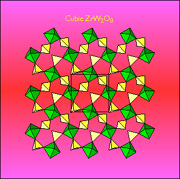

ZrW2O8 is a ceramic with negative thermal expansion over a wide temperature range, 0-1050 K. Because the crystal structure is cubic, the negative thermal expansion is isotropic. Other materials have been found with a negative thermal expansion along one axis, but a normal positive expansion along other axes. A related material is ZrP2O7, and when this is doped with V replacing P the thermal expansion is also negative over a restricted range of temperatures. Much of the experimental work on these ceramics has been carried out by Art Sleight in Oregon.

When the news about the thermal expansion in ZrW2O8 hit the headlines in March 1996, we thought that we may be able to say something useful using our Rigid Unit Mode (RUM) model. The structure of ZrW2O8 consists of a framework of ZrO6 octahedra and WO4 tetrahedra linked at corners, but with one of the corners of the WO4 tetrahedra remaining unlinked. In the ZrP2O7 structure the basic topology of linked ZrO6 octahedra and PO4 tetrahedra is similar, but the missing oxygen is taken into account by the additional linkage between the PO4 tetrahedra, leaving no non-bridging bonds. This is perhaps getting a bit complicated, but the real point is that our RUM model may be able to explain the thermal expansion in these materials. Our simple picture is that in a framework of linked rigid (or nearly rigid) octahedra and tetrahedra, a rotation of one unit will cause a small volume reduction. When all units can rotate due to thermal motion they will together pull the structure inwards proportional to the mean-square rotation, and since the mean-square rotation angle increases with temperature, there will be greater reduction at higher temperatures. Hence you can get a negative thermal expansion. Whether this works for you depends on the balance with the factors that normally give rise to a positive thermal expansion, such as expansion of the Zr-O and W-O bonds.
Our analysis of ZrW2O8 showed that there are enough RUMs to give a negative thermal expansion, and we supported our analysis with some calculations of the thermal expanson and Gruneison parameter using simple pair potentials we developed. Our model can account for the absence of a significant affect of the high-tempertaure order/disorder phase transition.
On the other hand, there appear to be no RUMs in the ZrP2O7 structure, which we can explain as a result of the additional cross-bracing of the structure to accomodate the missing oxygen. We therefore have to suggest that the mechanism of thermal expansion in the V-doped materials is different from that operating in ZrW2O8, and it seems likely that it arises from the presence of orientational disorder similar to that found in cubic cristobalite as a result of the structure trying to avoid the presence of linear P-O-P bonds. However, this disorder is likely to lead to some distortions of the ZrO6 octahedra.
Credit is due to Alix Pryde (who did a lot of the hard work), my colleagues Kenton Hammonds and Volker Heine (who have been involved in the main programme on the RUM model), Julian Gale (who helped with the pair potentials), and Michel Warren (who did some supported ab initio calculations).
Our papers on this subject include (in reverse chronological order):
A K A Pryde, K D Hammonds, M T Dove, V Heine, J D Gale and M C Warren, "Rigid units and the negative thermal expansion in ZrW2O8". Phase Transitions (in press)
This is a slightly simpler version of the next reference.
A K A Pryde, K D Hammonds, M T Dove, V Heine, J D Gale and M C Warren, "Origin of the negative thermal expansion in ZrW2O8 and ZrP2O7". Journal of Physics: Condensed Matter 8}, 10973-10982, 1996.
This gives the full story with pictures.
I P Swainson and M T Dove. "On the thermal expansion of beta-cristobalite". Physics and Chemistry of Minerals 22, 61-65, 1995.
This is nothing to do with ZrW2O8 per se, but it does contain the ideas of how thermal expansion is affected by the rotations of rigid tetrahedra, and the ideas associated with the structure of the cubic phase of cristobalite are relevant to ZrP2O7.
Link back to ...